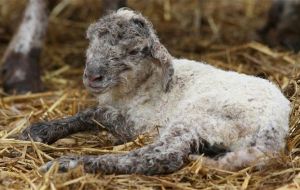MercoPress. South Atlantic News Agency
Schmallenberg disease hitting lambs and calves spreads to all England and Wales
 The disease causes severe deformities in lambs and calves born to infected mothers
The disease causes severe deformities in lambs and calves born to infected mothers A disease that can lead to lambs and calves being stillborn or deformed has spread to every county in England and Wales. Some farmers are expected to lose livestock during the lambing season, which is just getting underway.
Schmallenberg virus was first detected in the UK earlier this year in the south and east of England. It has spread rapidly during the summer, probably through midges, say government scientists.
“We've seen quite rapid geographic spread,” the government's Chief Veterinary Officer, Nigel Gibbens, told the BBC.
“That means a lot of herds and flocks will have been exposed to the disease. The likelihood is that many of them won't show disease because they weren't infected at the right time to show disease.
”Some will - in those herds and flocks we expect an impact of 2-5% of their lambs and calves.“
Schmallenberg causes severe deformities in lambs and calves born to infected mothers, but adults usually recover quickly. Cases have been documented on 976 farms in England and Wales, compared with 276 in August.
However, officials believe the true number of cases is higher. The first sign is often when livestock give birth to deformed or dead young - which can be months after the infection has occurred.
In areas where the disease has been found, the number of infected flocks and herds is likely to be ”very high“, said Mr Gibbens.
Alasdair Cook, head of endemic food-borne zoo-noses at the Animal Health Veterinary Laboratories Agencies, said farmers should be vigilant for signs of infection, particularly when livestock are giving birth.
”The infection has been transmitted through the whole of England and Wales, effectively, up to the Scottish borders,” he said.
The new emerging livestock disease was identified late last year, near the German town of Schmallenberg. It has since been detected in Belgium, Germany, the Netherlands and the UK.
It is believed the virus was carried to England by midges blown across the Channel and was then spread by native midges during the summer.
Evidence from Europe suggests that around 6% of infected sheep flocks (and 4% of infected cattle herds) will suffer symptoms from the disease, which is only dangerous when it is passed to the unborn lamb or calf. Flocks that are infected should expect to lose between 2% and 5% of lambs.
There is a low likelihood of any risk to public health, according to the European Centre for Disease Prevention and Control. A vaccine is being developed, which if proved safe and effective, could be available in the UK in time for next year's lambing season, said Mr Gibbens. (BBC).




Top Comments
Disclaimer & comment rules-

-

-

Read all commentsI have no idea what this has to do with Latin America.
Dec 19th, 2012 - 12:23 pm 0Sorry hold, but it does and as a farmer I am worried that it will spread here. The Europeans are very strict about animal health standards in South America but are very sloppy about controlling thier own research stations. This latest disease “escaped” from a research station in Germany. The last outbreak of foot and mouth disease in UK emanated from a research laboratory in Kent. Not to mention the feeding of sheeps brains infected with scrapie to cattle which created BSE and its related human diseases which killed a number of people. Well out here we dont allow those sloppy practices to kill people
Dec 19th, 2012 - 05:43 pm 0Just another day in disease-ridden Europe.
Dec 19th, 2012 - 08:49 pm 0Commenting for this story is now closed.
If you have a Facebook account, become a fan and comment on our Facebook Page!